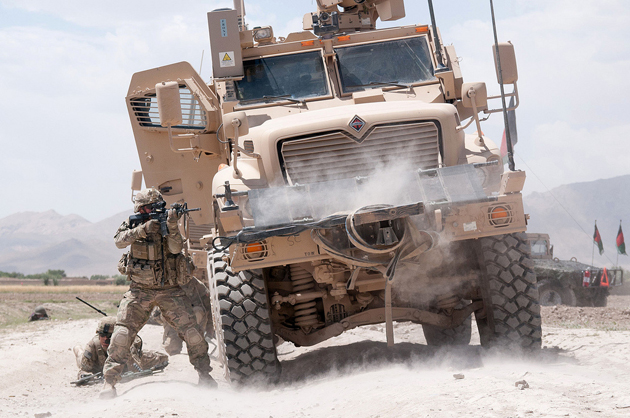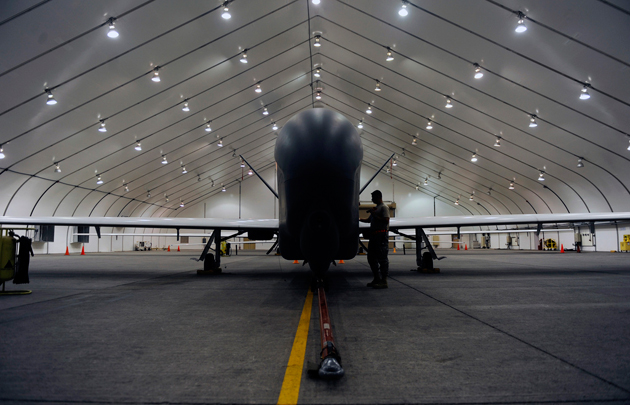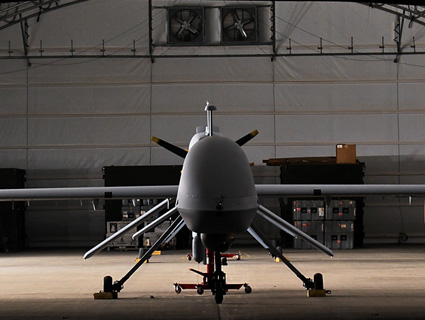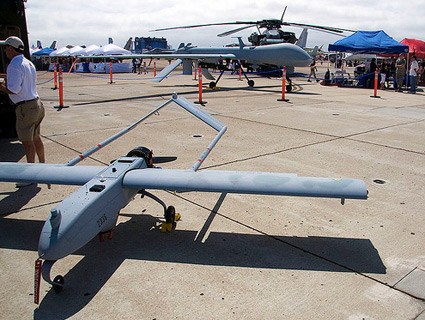
<a href="http://www.flickr.com/photos/soldiersmediacenter/7507223384/in/photostream/">The U.S. Army</a>/Flickr
This story first appeared on the TomDispatch website.
Americans may feel more distant from war than at any time since World War II began. Certainly, a smaller percentage of us—less than 1%—serves in the military in this all-volunteer era of ours and, on the face of it, Washington’s constant warring in distant lands seems barely to touch the lives of most Americans.
And yet the militarization of the United States and the strengthening of the National Security Complex continues to accelerate. The Pentagon is, by now, a world unto itself, with a staggering budget at a moment when no other power or combination of powers comes near to challenging this country’s might.
In the post-9/11 era, the military-industrial complex has been thoroughly mobilized under the rubric of “privatization” and now goes to war with the Pentagon. With its $80 billion-plus budget, the intelligence bureaucracy has simply exploded. There are so many competing agencies and outfits, surrounded by a universe of private intelligence contractors, all enswathed in a penumbra of secrecy, and they have grown so large, mainly under the Pentagon’s aegis, that you could say intelligence is now a ruling way of life in Washington—and it, too, is being thoroughly militarized. Even the once-civilian CIA has undergone a process of para-militarization and now runs its own “covert” drone wars in Pakistan and elsewhere. Its director, a widely hailed retired four-star general, was previously the US war commander in Iraq and then Afghanistan, just as the National Intelligence Director who oversees the whole intelligence labyrinth is a retired Air Force lieutenant general.
In a sense, even the military has been “militarized.” In these last years, a secret army of special operations forces, 60,000 or more strong and still expanding, has grown like an incubus inside the regular armed forces. As the CIA’s drones have become the president’s private air force, so the special ops troops are his private army, and are now given free rein to go about the business of war in their own cocoon of secrecy in areas far removed from what are normally considered America’s war zones.
Diplomacy, too, has been militarized. Diplomats work ever more closely with the military, while the State Department is transforming itself into an unofficial arm of the Pentagon—as the secretary of state is happy to admit — as well as of the weapons industry.
And keep in mind that we now have two Pentagons, thanks to the establishment of the Department of Homeland Security (DHS), which is focused, among other things, on militarizing our southern border. Meanwhile, with the help of the DHS, local police forces nationwide have, over the last decade, been significantly up-armored and have, in the name of fighting terrorism, gained a distinctly military patina. They have ever more access to elaborate weaponry and gadgets, including billions of dollars of surplus military equipment of every sort, often being funneled to once peaceable small town police departments.
The Military Solution in the Greater Middle East
Militarization in this country is hardly a new phenomenon. It can be traced back decades, but the process hit warp speed in the post-9/11 years, even if the US still lacks the classic look of a militarized society. Almost unnoticed has been an accompanying transformation of the mindset of Washington—what might be called the militarization of solutions.
If the institutions of American life and governance are increasingly militarized, then it shouldn’t be surprising that the problems facing the country are ever more often framed in militarized terms and that the only solutions considered are similarly militarized. This paucity of imagination, this constraining of what might be possible, seems especially evident in the Greater Middle East.
In fact, Washington’s record there, seldom if ever collected in one place, should be eye-opening. Start with a dose of irony: before the invasion of Iraq in 2003, it was a commonplace among neoconservatives to label the region extending across the oil heartlands of the planet, from North Africa to the Chinese border in Central Asia, “the arc of instability.” After a decade in which Washington has applied its military might and thoroughly militarized solutions to the region, that decade-old world now looks remarkably “stable.”
Here, in shorthand, is a little regional scorecard of what American militarization has meant in the Greater Middle East, 2001-2012:
Pakistan: The US has faced a multitude of complex problems in this nuclear nation beset with insurgent movements, its tribal areas providing sanctuary to both Afghan and Pakistani rebels and jihadis, and its intelligence service entangled in a complicated relationship with the Taliban leadership as well as other rebel groups fighting in Afghanistan. Washington’s response has been—as Secretary of Defense Leon Panetta recently labeled it—war. In 2004, the Bush administration launched a drone assassination campaign in the country’s tribal borderlands largely focused on al-Qaeda leaders (combined with a few cross-border special forces raids). Those rare robotic air strikes have since expanded into something like a full-scale covert drone war that is killing civilians, is intensely unpopular throughout Pakistan, and by now is clearly meant to punish the Pakistani leadership for its transgressions as well.
Frustrated by what they consider Pakistani intransigence, elements in the US military and intelligence community are reportedly pressing to add a new set of cross-border joint special operations/Afghan commando raids to the present incendiary mix. American air strikes from Afghanistan that killed 24 Pakistani soldiers last November, with no apologies offered for seven months, brought to a boil a crisis in relations between Washington and Islamabad, with the Pakistani government closing off the country to American war supplies headed for Afghanistan. (That added a couple of billion dollars to the Pentagon’s expenses there before the crisis was ended with a grudging apology this week). The whole process has clearly contributed to the destabilization of nuclear Pakistan.
Afghanistan: Following a November 2001 invasion (light on invading US troops), the US opted for a full-scale occupation and reconstruction of the country. In the process, it managed to spur the reconstruction and reconstitution of the previously deeply unpopular and defeated Taliban movement. An insurgent war followed. Despite a massive surge of US forces, CIA agents, special operations troops, and private contractors into the country, the calling in of air power in a major way, and the expansion of a program of “night raids” by special ops types and the CIA, success has not followed. By the end of 2014, the US is scheduled to withdraw its main combat forces from what is likely to be a thoroughly destabilized country.
 Iran: In a program long aimed at regime change (but officially focused on the country’s nuclear program), the US has clamped energy sanctions—often seen as an act of war—on Iran, supported a special operations campaign of unknown proportions (including cross-border actions), run a massive CIA drone surveillance program in the country’s skies, and (with the Israelis) loosed at least two major malware “worms” against the computer systems and centrifuges of its nuclear facilities, which even the Pentagon defines as acts of war. It has also backed a massive build-up of US naval and air power in the Persian Gulf and of military bases in countries on Iran’s peripheries, along with “comprehensive multi-option war-planning” for a possible 2013 strike at Iran’s nuclear facilities. (Though little is known about it, an assassination campaign against Iranian nuclear scientists has usually been blamed on the Israelis. Now that the joint US-Israeli authorship of acts of cyberwar against Iran has been confirmed, however, it is at least reasonable to wonder whether the US might also have had a hand in these killings.) All of this has embroiled the region and brought it to the edge of yet more war, while in no obvious way shaking the Iranian regime.
Iran: In a program long aimed at regime change (but officially focused on the country’s nuclear program), the US has clamped energy sanctions—often seen as an act of war—on Iran, supported a special operations campaign of unknown proportions (including cross-border actions), run a massive CIA drone surveillance program in the country’s skies, and (with the Israelis) loosed at least two major malware “worms” against the computer systems and centrifuges of its nuclear facilities, which even the Pentagon defines as acts of war. It has also backed a massive build-up of US naval and air power in the Persian Gulf and of military bases in countries on Iran’s peripheries, along with “comprehensive multi-option war-planning” for a possible 2013 strike at Iran’s nuclear facilities. (Though little is known about it, an assassination campaign against Iranian nuclear scientists has usually been blamed on the Israelis. Now that the joint US-Israeli authorship of acts of cyberwar against Iran has been confirmed, however, it is at least reasonable to wonder whether the US might also have had a hand in these killings.) All of this has embroiled the region and brought it to the edge of yet more war, while in no obvious way shaking the Iranian regime.
Iraq: The US invaded in March 2003, occupying the country. It fought (and essentially lost) an eight-year-long counterinsurgency war, withdrawing its last troops at the end of 2011, but leaving behind in Baghdad the world’s largest, most militarized embassy. The country, now an ally and trading partner of Iran, remains remarkably unreconstructed and significantly destabilized, with regular bombing campaigns in its cities.
Kuwait: Just across the border from Iraq, the US has continued a build-up of forces. In the future, according to a US Senate report, there could be up to 13,000 US personnel permanently stationed in the country.
Yemen: Washington, long a supporter of the country’s strong-man ruler, now backs the successor regime. (In Yemen, as elsewhere, Washington has been deeply uncomfortable with Arab-Spring-style democracy movements among its allies.) For years, it has had an air campaign underway in the southern part of the country aimed at insurgents linked to al-Qaeda in the Arabian Peninsula (AQAP). More recently, it has put at least small numbers of special operations troops on the ground there as advisers and trainers and has escalated a combined CIA drone and Air Force manned-plane air campaign in southern Yemen. There have been at least 23 air strikes already this year, evidently causing significant civilian casualties, reportedly radicalizing southerners, increasing support for AQAP, and helping further destabilize this impoverished and desperate land.
Bahrain: Home of the US Fifth Fleet, tiny Bahrain, facing a democratic uprising of its repressed Shiite majority, called in the Saudi military on a mission of suppression. The US has offered military aid and support to the ruling Sunni monarchy.
Syria: In radically destabilized Syria, where a democracy uprising has morphed into a civil war with sectarian overtones that threatens to further destabilize the region, including Lebanon and Iraq, the CIA has now been dispatched to the Turkish border. Its job: to direct weapons to rebels of Washington’s choice (assuming that the CIA, with its dubious record, can sort the democrats from the jihadis). The weapons themselves are arriving, according to the New York Times, via a “network of intermediaries including Syria’s Muslim Brotherhood and paid for by Turkey, Saudi Arabia, and Qatar.” It’s a project that has “this can’t end well” written all over it.
Somalia: Long a failed state, Somalia has suffered, among other things, through a US-fostered Ethiopian invasion back in 2006 (and another more recently), drone attacks, CIA and special forces operations, a complicated US program to subsidize a force of African (especially Ugandan) troops in the capital and support for a Kenyan invasion in the south—each step in the process seemingly leading to further fragmentation, further radicalization, and greater extremism.
Egypt: Ever since Tahrir Square, Washington has been focused on its close ties with the Egyptian military high command (key figures from which visit Washington every year) and on the billions of dollars in military aid it continues to provide to that military, despite the way it has usurped democratic rule.
Libya: The Obama administration called in the US Air Force (along with air power from NATO allies) to support an inchoate uprising and destroy the regime of long-time strong-man Muammar Gaddafi. In this they were successful. The long-term results still remain unknown. (See, for instance, the Islamist revolt in destabilized neighboring Mali.)
How to Set the Planet on Fire and Learn Nothing
This remains a partial list, lacking, to give but one example, the web of drone bases being set up from the Seychelles Islands and Ethiopia to the Arabian Peninsula—clearly meant for expanded drone wars across the region. Nonetheless, it is a remarkable example of the general ineffectiveness of applying military or militarized solutions to the problems of a region far from your own shores. From Pakistan and Afghanistan to Yemen and Somalia, the evidence is already in: such “solutions” solve little or nothing, and in a remarkable number of cases seem only to increase the instability of a country and a region, as well as the misery of masses of people.
And yet the general lack of success from 2002 on and a deepening frustration in Washington have just led to a stronger conviction that some recalibrated version of a military solution (greater surges, lesser surges, no invasions but special forces and drones, smaller “footprint,” larger naval presence, etc.) is the only reasonable way to go.
In fact, military solutions of every sort have such a deep-seated grip on Washington that the focus there might be termed obsessive. This has been particularly obvious when it comes to the CIA’s drone wars. Back in the Vietnam War years, President Lyndon Johnson was said to have driven his generals crazy by “micromanaging” the conflict, especially in weekly lunch meetings in which he insisted on picking specific targets for the air campaign against North Vietnam.
These days, however, Johnson almost looks like a laissez-faire war president. After all, thanks to the New York Times, we know that the White House has a “nominating” process to compile a “kill list” of terror suspects, and that the president himself decides which drone air attacks should then be launched, not target area by target area, but individual by individual. He is choosing specific individuals to kill in the Pakistani, Yemeni, and Somali backlands.
It should be considered a sign of the times that, whatever shock this news may have caused in Washington (mainly because of possible administration leaks about the nature of the “covert” drone program), few have even mentioned presidential micromanaging, nor, it seems, are any generals up in arms. Some may have found the “nomination” process shocking, but rare are those who seem to think it strange that a president of the United States should be involved in choosing individuals (including US citizens) for assassination-by-drone in distant lands.
The truth is that such “solutions,” first tested in the Greater Middle East, are now being applied (even if, as yet, in far more modest ways) from Africa to Central America. In Africa, I suspect you could track the growing destabilization of parts of that continent to the setting up of a US command for the region (Africom) in 2007 and in subsequent years the slow movement of drones, special forces operatives, private contractors, and others into a region that already has problems enough.
Here’s a 2012 American reality then: as a great power, the US has an increasingly limited toolkit, into which it is reaching far more often for ever more similar tools. The idea that the globe is a chessboard, that Washington is in control of the game, and that each militarized move it makes will have a reasonably predictable result couldn’t be more dangerous. The evidence of the last decade is clear enough: there is little less predictable or more likely to go awry than the application of military force and militarized solutions, which are cumulatively incendiary in unexpected ways, and in the end threaten to set whole regions on fire. None of this, however, seems to register in Washington.
The United States is commonly said to be a great power in decline, but the militarization of American policy—and thinking—at home and abroad is not. It has Washington, now a capital of perpetual war, in its grip.
This process began, post-9/11, with the soaring romanticism of the Bush administration about, as the president put it, the power of the “greatest force for human liberation the world has ever known” (a.k.a. the US military) to change the world. It was a fundamental conviction of Bush and his top officials that the most powerful military on the planet could bring any state in the Greater Middle East to heel in a “cakewalk.”
Today, in the wake of two failed wars on the Eurasian continent, a de-romanticized version of that conviction has become the deeply embedded, increasingly humdrum way of life of a militarized Washington. It will remain so.
If Barack Obama, the man who got Bin Laden, is reelected, nothing of significance is likely to change in this regard. If Mitt Romney wins, the process is likely to accelerate, possibly moving from global misfire, failure, and obsession to extreme global fantasy, with consequences—from Iran to Russia to China—difficult now to imagine.
Tom Engelhardt, co-founder of the American Empire Project and author of The United States of Fear as well as The End of Victory Culture, runs the Nation Institute’s TomDispatch.com. His latest book, co-authored with Nick Turse, is Terminator Planet: The First History of Drone Warfare, 2001-2050. To listen to Timothy MacBain’s latest Tomcast audio interview in which Engelhardt discusses drone warfare and the Obama administration, click here or download it to your iPod here. Follow TomDispatch on Twitter @TomDispatch and join us on Facebook. To stay on top of important articles like these, sign up to receive the latest updates from TomDispatch.com here.
[Note for TomDispatch readers: Those of you who want some background on the post-Vietnam militarization of this country should get your hands on a copy of Andrew Bacevich’s 2005 book, The New American Militarism: How Americans Are Seduced By War. It’s a must-read. Rachel Maddow was clearly strongly influenced by it in her new bestseller, Drift: The Unmooring of American Military Power.]














